“Conch Shell-Cutter by Solvyns” has been added to your cart.
View cart
-
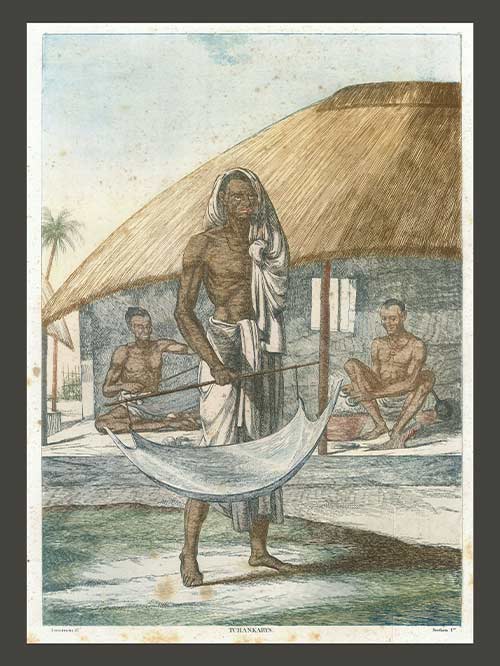

by Francois-Balthazar Solvyns (1760-1824)
Original coloured etching
from Les Hindous
Pub. Paris
Solvyns’ portrayal of a craftsman wielding the distinctive sankha-karat saw, encapsulates the specialised craftsmanship of the Sakhari caste of conch shell bangles cutters in Calcutta. Occupying their own neighborhood, or tola, within the city, Sakhari artisans use the three-foot-long crescent-shaped saw to intricately cut and shape conch shells. Utilising an iron saw without teeth, akin to those used for marble, the craftsman achieves precise cuts through sustained friction, anchoring the shell between his feet for stability, as depicted in the background. Following cutting, the shells undergo refinement through rubbing against a hard stone with sand and water to ensure smooth surfaces. Subsequently, the rings are meticulously adjusted, adorned with red gum or wax to conceal joints, and polished or engraved as required, culminating in the creation of finished bangles. These red conch shell bangles symbolise marriage for Bengali women of “respectable castes,” akin to the red streak in their hair part, and are preferred over glass and metal alternatives.
Frans Balthazar Solvyns, was a skilled engraver and painter hailing from Antwerp, embarked on a transformative journey to India in 1790. Settling in Calcutta, Solvyns immersed himself in the intricacies of Indian life, studying Hindi and forging relationships with Brahmins and pundits. Inspired by his surroundings, he commenced his ambitious project in 1791, aiming to depict the diverse facets of Indian society, from occupations to customs which he published in a series of engravings. Despite its sensitive portrayal, the venture encountered little success initially, prompting Solvyns’ departure from India in 1803. However, his legacy endured through subsequent publications, notably “The Costume of Hindoostan” and the expanded edition of “Les Hindous,” offering an intimate and detailed glimpse into 18th-century Indian life across professions, festivals, and daily rituals, immortalising a unique historical moment with both reverence and curiosity.
Image Size (cms): 35(H) x 24(W)
Image Size (inches): 14(H) x 9.5(W)
Mount Size (cms): 51(H) x 41(W)
Mount Size (inches): 20(H) x 16(W)
-
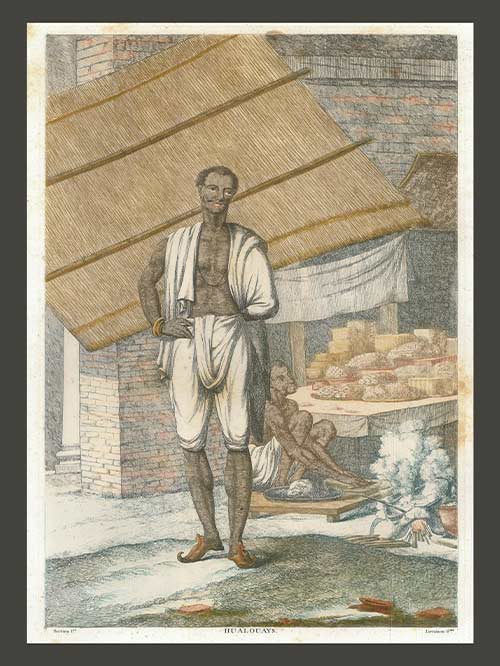

by Francois-Balthazar Solvyns (1760-1824)
Original coloured etching
from Les Hindous
Pub. Paris
Halwais confectioners, specialise in making a variety of sweets using a flour base, distinctive to North India, unlike the milk and sugar-based Bengali sweets prepared by Mayaras. Their name derives from “halwa,” a sweet made of flour, ghee, sugar, and often flavoured with cardamom and almonds, sometimes coloured with saffron and mixed with raisins or pistachio nuts. The confections are prepared through various methods, such as frying flour in ghee, boiling it in milk and sugar, or baking in earthen pans. Puddings, including those with grated vegetables like carrots, are popular, while delicate varieties use cream, demanding skill in preparation. Despite the Arabic origin of the term “halwa,” Halwais are Hindu Sudras, not Muslims, and they play a significant role in Hindu festivities and ceremonies, supplying sweetmeats for various occasions.
Frans Balthazar Solvyns, was a skilled engraver and painter hailing from Antwerp, embarked on a transformative journey to India in 1790. Settling in Calcutta, Solvyns immersed himself in the intricacies of Indian life, studying Hindi and forging relationships with Brahmins and pundits. Inspired by his surroundings, he commenced his ambitious project in 1791, aiming to depict the diverse facets of Indian society, from occupations to customs which he published in a series of engravings. Despite its sensitive portrayal, the venture encountered little success initially, prompting Solvyns’ departure from India in 1803. However, his legacy endured through subsequent publications, notably “The Costume of Hindoostan” and the expanded edition of “Les Hindous,” offering an intimate and detailed glimpse into 18th-century Indian life across professions, festivals, and daily rituals, immortalising a unique historical moment with both reverence and curiosity.
Image Size (cms): 35(H) x 24(W)
Image Size (inches): 14(H) x 9.5(W)
Mount Size (cms): 51(H) x 41(W)
Mount Size (inches): 20(H) x 16(W)
-

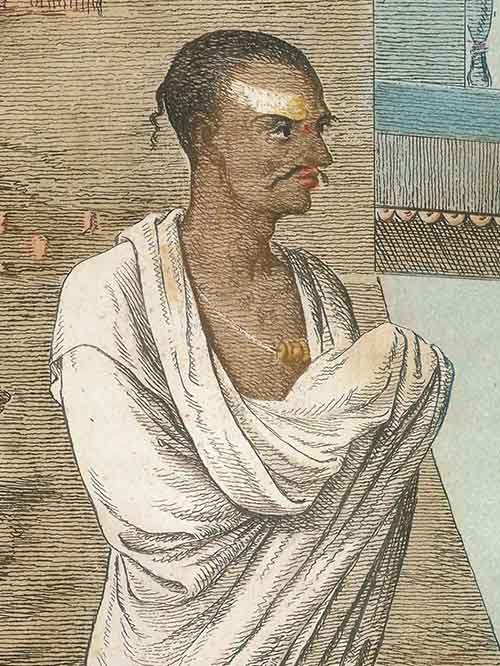
by Francois-Balthazar Solvyns (1760-1824)
Original coloured etching
from Les Hindous
Pub. Paris
Frans Balthazar Solvyns, was a skilled engraver and painter hailing from Antwerp, embarked on a transformative journey to India in 1790. Settling in Calcutta, Solvyns immersed himself in the intricacies of Indian life, studying Hindi and forging relationships with Brahmins and pundits. Inspired by his surroundings, he commenced his ambitious project in 1791, aiming to depict the diverse facets of Indian society, from occupations to customs which he published in a series of engravings. Despite its sensitive portrayal, the venture encountered little success initially, prompting Solvyns’ departure from India in 1803. However, his legacy endured through subsequent publications, notably “The Costume of Hindoostan” and the expanded edition of “Les Hindous,” offering an intimate and detailed glimpse into 18th-century Indian life across professions, festivals, and daily rituals, immortalising a unique historical moment with both reverence and curiosity.
Image Size (cms): 35(H) x 24(W)
Image Size (inches): 14(H) x 9.5(W)
Mount Size (cms): 51(H) x 41(W)
Mount Size (inches): 20(H) x 16(W)
-
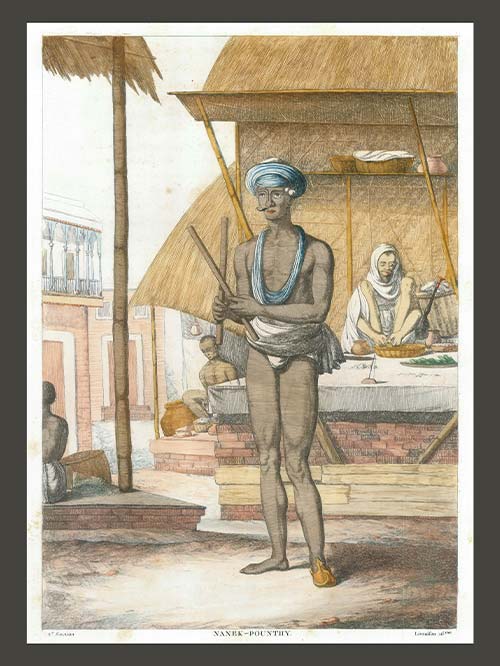

by Francois-Balthazar Solvyns (1760-1824)
Original coloured etching
from Les Hindous
Pub. Paris
Solvyns describes the Nanuk-Punthys as a unique and relatively peaceful group of Faquirs, distinguished by their peculiar appearance, including wearing only half a moustache and one shoe. They adorn their turbans with silver bells, and carry sticks which they continuously strike together while reciting prayers and legends with remarkable speed. Some Nanuk-Punthys roam markets and public places, while others visit houses and shops, engaging in perpetual harangues. Despite their eccentricities, they are generally treated with respect, particularly among Sikhs and Marathas. Solvyns’ portrayal of the Nanuk-Punthys presents a puzzling depiction that doesn’t neatly align with known religious sects or orders of the time. While the term “Nanak Panthi” typically refers to followers of Guru Nanak, the lack of clear identification in Solvyns’ description leaves scholars and historians uncertain about their exact classification within the religious landscape of the period.
Frans Balthazar Solvyns, was a skilled engraver and painter hailing from Antwerp, embarked on a transformative journey to India in 1790. Settling in Calcutta, Solvyns immersed himself in the intricacies of Indian life, studying Hindi and forging relationships with Brahmins and pundits. Inspired by his surroundings, he commenced his ambitious project in 1791, aiming to depict the diverse facets of Indian society, from occupations to customs which he published in a series of engravings. Despite its sensitive portrayal, the venture encountered little success initially, prompting Solvyns’ departure from India in 1803. However, his legacy endured through subsequent publications, notably “The Costume of Hindoostan” and the expanded edition of “Les Hindous,” offering an intimate and detailed glimpse into 18th-century Indian life across professions, festivals, and daily rituals, immortalising a unique historical moment with both reverence and curiosity.
Image Size (cms): 35(H) x 24(W)
Image Size (inches): 14(H) x 9.5(W)
Mount Size (cms): 51(H) x 41(W)
Mount Size (inches): 20(H) x 16(W)
-
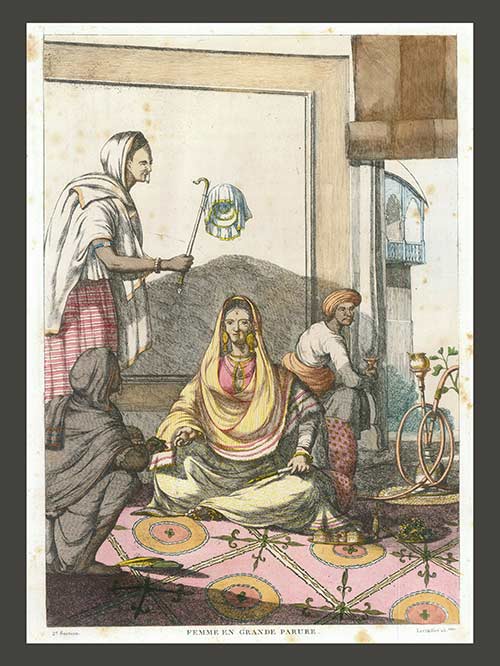

by Francois-Balthazar Solvyns (1760-1824)
Original coloured etching
from Les Hindous
Pub. Paris
Solvyns provides a vivid portrayal of a wealthy Hindu woman in full dress, emphasising both the magnificence of her attire and the richness of her surroundings. The woman is seated on a luxurious carpet, with her legs and arms supported by embroidered silk cushions. She is attended by two ayahs (maid servants). One maid offers her paan while another fans her with a hand pankh to refresh the air around her face. In the background, a hookah-bearer prepares the hookah for her to smoke. The lady’s appearance is meticulously described: her hair, made shiny with cocoa oil, is plaited and adorned with pearls or precious stones, with the largest gem positioned in the middle. Solvyns highlights her isolation and idle life, noting that women of her rank live in seclusion, removed from both labor and society, their lives marked by a lack of purpose and contribution, engaging in minimal activities such as playing the tom-tom.
Frans Balthazar Solvyns, was a skilled engraver and painter hailing from Antwerp, embarked on a transformative journey to India in 1790. Settling in Calcutta, Solvyns immersed himself in the intricacies of Indian life, studying Hindi and forging relationships with Brahmins and pundits. Inspired by his surroundings, he commenced his ambitious project in 1791, aiming to depict the diverse facets of Indian society, from occupations to customs which he published in a series of engravings. Despite its sensitive portrayal, the venture encountered little success initially, prompting Solvyns’ departure from India in 1803. However, his legacy endured through subsequent publications, notably “The Costume of Hindoostan” and the expanded edition of “Les Hindous,” offering an intimate and detailed glimpse into 18th-century Indian life across professions, festivals, and daily rituals, immortalising a unique historical moment with both reverence and curiosity.
Image Size (cms): 35(H) x 24(W)
Image Size (inches): 14(H) x 9.5(W)
Mount Size (cms): 51(H) x 41(W)
Mount Size (inches): 20(H) x 16(W)











